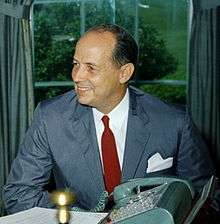Louisiana gubernatorial election, 1956
| | |||||||||||||||||||||||||||||||||||||||||||||||||||||||||||||||
| |||||||||||||||||||||||||||||||||||||||||||||||||||||||||||||||
| |||||||||||||||||||||||||||||||||||||||||||||||||||||||||||||||
| |||||||||||||||||||||||||||||||||||||||||||||||||||||||||||||||
| Elections in Louisiana |
|---|
 |
|
|
|
The Louisiana gubernatorial election of 1956 was held on January 17, 1956. The 1956 election saw the election of Earl K. Long to his second full term as Governor of Louisiana. He received over 50% of the vote, defeating his opponents so soundly that no runoff vote was needed.
Background
Like most Southern states between Reconstruction and the civil rights era, Louisiana's Republican Party was virtually nonexistent in terms of electoral support. This meant that the Democratic Party primary held on this date was the real contest over who would be governor.
Candidates
Outgoing Governor Robert F. Kennon was constitutionally barred from succeeding himself. The candidates running to replace him were:
- Earl K. Long of Winnfield, the head of the state's Longite faction, who has previously been governor from 1939 to 1940 and from 1948 to 1952.
- deLesseps Morrison, mayor of New Orleans since 1946. The 1956 election was the first of Morrison's three failed bids for governor.
- Fred Preaus, a car dealer and former member of the Farmerville Town Council, had been Director of Highways under Governor Kennon, and received Kennon's support.
- Francis Grevemberg of Lafayette was known for his high-profile gambling raids as State Police Superintendent. Grevemberg campaigned on his reputation for integrity, but his gambling crackdown had alienated too many people for him to receive much support.
- James M. McLemore, an Alexandria cattleman, ran as a segregationist candidate in his second straight gubernatorial bid.
Campaign
Long's campaign promises included spending increases to fund health, education, and other social programs. He made these promises on an extensive tour of the state, stopping in nearly every town to deliver theatrical speeches mocking his opponents. The acerbic Long attacked Morrison with particular enthusiasm, mocking his toupee and fancy suits and calling him "as slick as a peeled onion", out of touch with residents of small towns and rural areas. Long also mocked his unusual first name: "Ole De la Soups is the only man that can talk out of both sides of his mouth, whistle, and strut all at once." In addition to his usual base, Long also won support from corrupt rural sheriffs who were angry at their loss of gambling revenues after Kennon's reforms and Grevemberg's raids.
Despite the reluctance of Morrison's own Crescent City Democratic Association, the New Orleans mayor was overly optimistic at his chances. Morrison had expected the support of Governor Kennon, but did not get it; Morrison had endorsed Kennon's opponent Hale Boggs in the first primary of the 1952 election. Long encouraged false optimism in Morrison's campaign by having his rural supporters write to the New Orleans mayor urging him to run for governor. This false rural support never materialized in the actual election; Morrison was too unfamiliar with the state's rural politics and fought a perception of urban sophistication that did not play well in the country. His emphasis on his record as mayor and his promises of economic development found little resonance with rural voters.
Results
Democratic Party Primary, January 17
| Candidate | Votes received | Percent |
|---|---|---|
| Earl Long | 421,681 | 51.44% |
| deLesseps Morrison | 191,576 | 23.37% |
| Fred Preaus | 95,955 | 11.71% |
| Francis Grevemberg | 62,309 | 7.60% |
| James M. McLemore | 48,188 | 5.88% |
Earl Long won 62 of the state's 64 parishes; only Orleans Parish went to Morrison. The support of local political boss Leander Perez won Plaquemines Parish for Fred Preaus, who lost his own Union Parish. Long was intensely proud of his first-primary victory, exclaiming "Huey never done that!"
| Preceded by 1952 gubernatorial election |
Louisiana gubernatorial elections | Succeeded by 1959-60 gubernatorial election |
Sources
Haas, Edward F. DeLesseps S. Morrison and the Image of Reform: New Orleans Politics, 1946-60. LSU Press, 1974.
Kurtz, Michael and Morgan Peoples. Earl K. Long: The Saga of Uncle Earl and Louisiana Politics. LSU Press, 1990.
Louisiana Secretary of State. Democratic Primary Election Returns, 1956.

